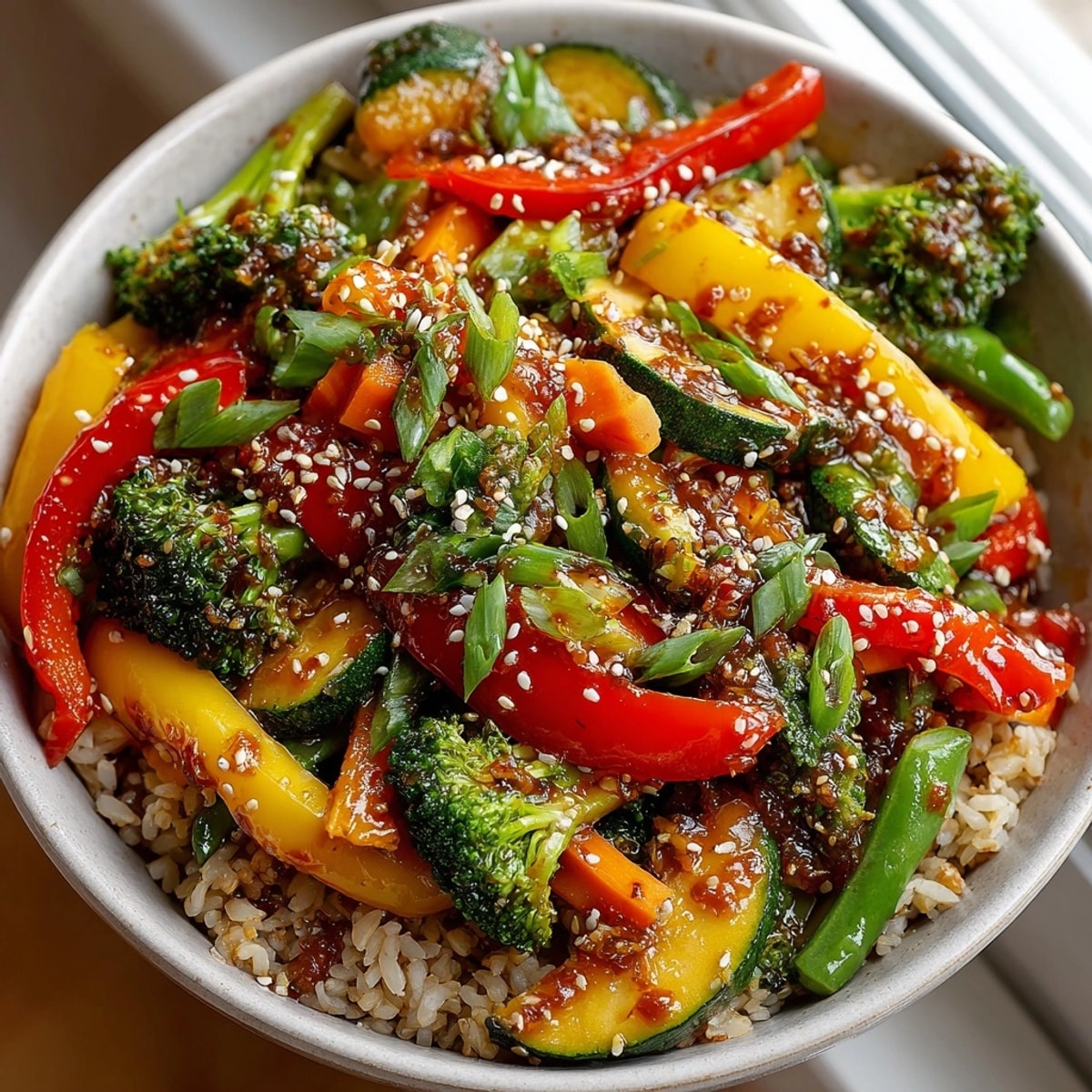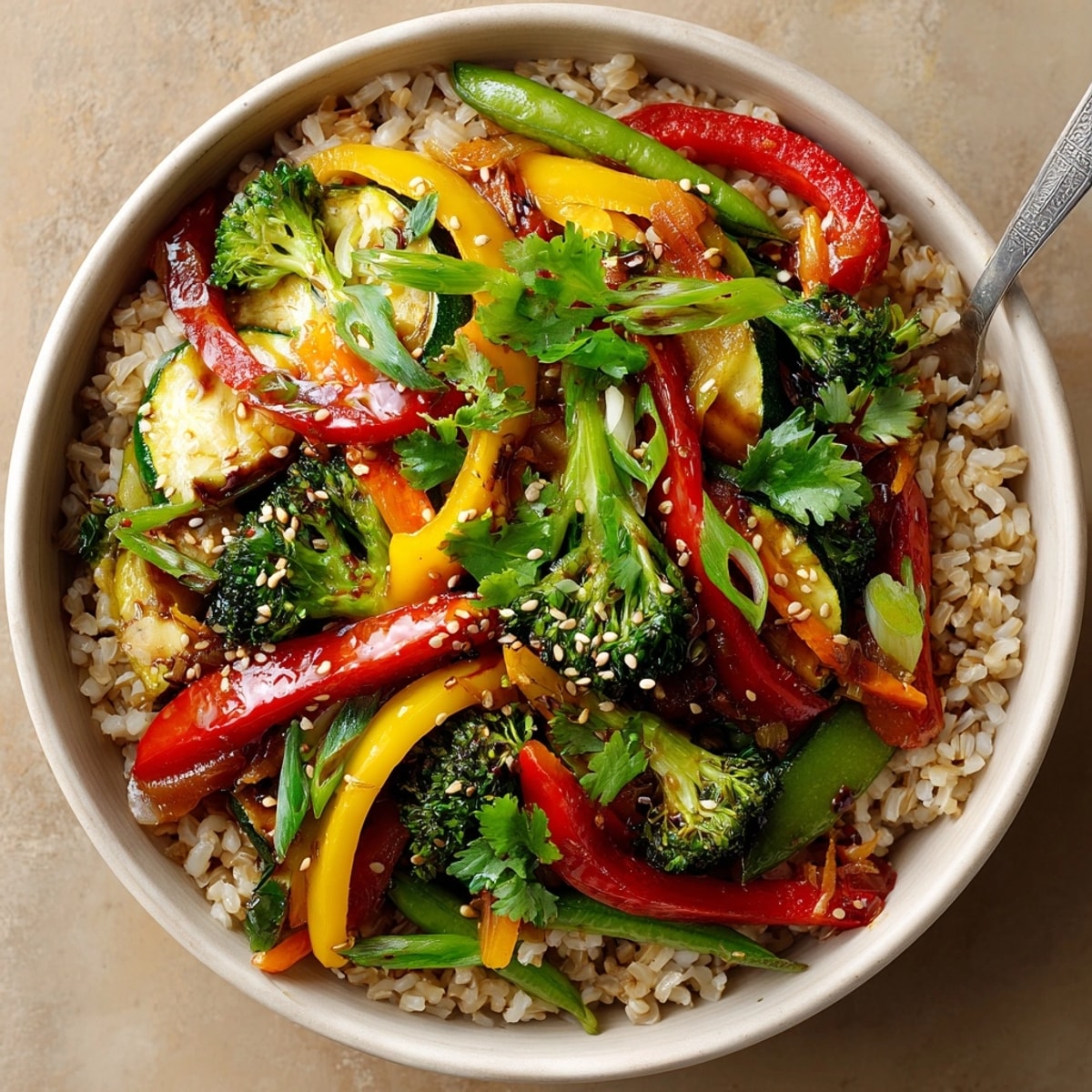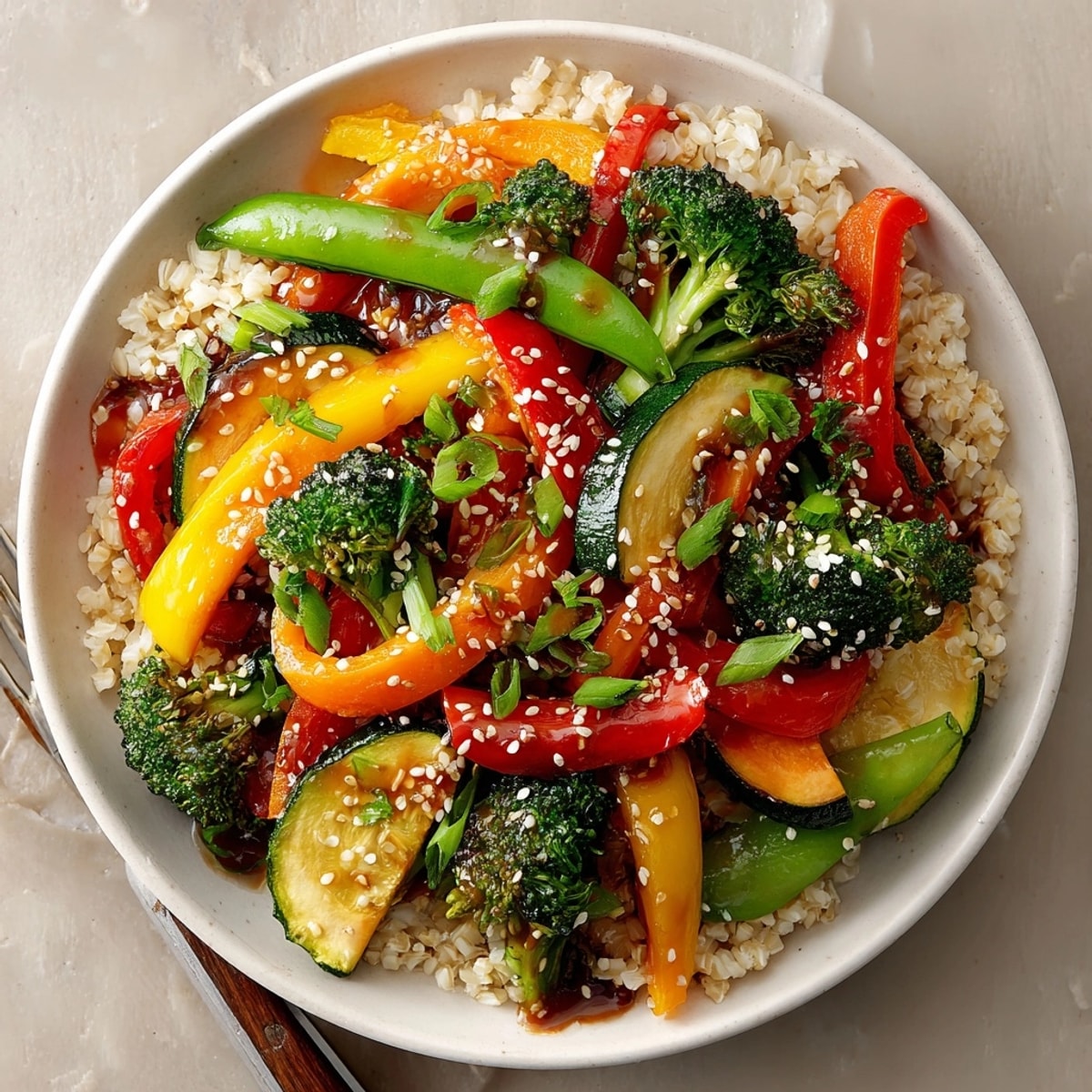 Save
Save This vibrant veggie stir fry with brown rice has been my weeknight salvation for years, combining colorful vegetables in a savory sauce that transforms simple ingredients into something spectacular without hours in the kitchen.
I first created this recipe during a particularly busy work week when I needed something healthy but quick. Now it's become our Monday reset meal after weekend indulgences, and my partner specifically requests it when we need a vegetable boost.
Ingredients
- Brown rice: Provides a nutty flavor and hearty base with more fiber than white rice. Look for short grain for stickier texture or basmati for fluffier results.
- Bell peppers: Red and yellow varieties add vibrant color and sweet flavor. Choose firm peppers with glossy skin.
- Carrots: Add natural sweetness and satisfying crunch. Select firm carrots with vibrant color.
- Broccoli: Contributes excellent texture and nutritional value. Look for tight, dark green florets.
- Sugar snap peas: Provide a delightful pop and freshness. Choose bright green pods that snap when bent.
- Zucchini: Absorbs the sauce beautifully. Select smaller zucchini for fewer seeds and better flavor.
- Green onions: Add a mild onion flavor without overpowering. Look for firm stalks with bright green tops.
- Fresh ginger: Creates aromatic warmth. Choose pieces that feel firm and smell fragrant when scratched.
- Fresh garlic: Provides essential aromatic base. Select heads with tight, plump cloves.
- Low sodium soy sauce: Adds umami depth without excessive salt. Tamari works perfectly for gluten free needs.
- Sesame oil: Creates distinctive nutty Asian flavor. A little goes a long way.
- Rice vinegar: Balances with bright acidity. Look for unseasoned varieties for better control.
- Natural sweetener: Maple syrup or honey rounds out flavors. Choose pure varieties without additives.
- Cornstarch: Creates silky sauce texture. Always mix with water before adding to prevent clumping.
- Sesame seeds: Add delightful crunch and visual appeal. Toast them briefly to enhance flavor.
Instructions
- Cook the rice:
- Begin by preparing brown rice according to package instructions, typically using a 1 to 2 ratio of rice to water. This takes longest, so start here. Brown rice usually requires about 40 minutes, which gives you ample time to prep vegetables while it cooks. Allow the rice to rest covered for 10 minutes after cooking for optimal fluffiness.
- Prepare the sauce:
- Whisk together soy sauce, sesame oil, rice vinegar, and your sweetener of choice in a small bowl. The combination creates a perfect balance of salty, nutty, tangy and sweet. Add the cornstarch slurry last, stirring until completely incorporated. This mixture will thicken beautifully when heated, creating a glossy sauce that clings to the vegetables.
- Heat your wok:
- Begin with a completely dry wok or large skillet over medium high heat. Allow it to heat thoroughly before adding oil. This prevents sticking and creates the proper environment for quick cooking. When the wok feels hot when you hold your hand above it, add your cooking oil and swirl to coat the surface.
- Cook aromatics:
- Add minced garlic and grated ginger to the hot oil, stirring constantly. These fragile ingredients burn easily, so keep them moving for about 30 seconds until they release their aroma but before they brown. This brief cooking releases their essential oils into the oil, flavoring everything that follows.
- Add hardy vegetables:
- Introduce carrots and broccoli first, as they require longer cooking. Stir fry vigorously for 2 to 3 minutes, keeping everything in motion. The vegetables should begin to brighten in color but retain their crispness. If the wok seems dry, you can add a tablespoon of water rather than more oil.
- Incorporate quicker cooking vegetables:
- Add bell peppers, zucchini, and sugar snap peas to the wok. Continue stir frying for 3 to 4 minutes until all vegetables are bright and crisp tender. You should be able to pierce them with a fork but still feel resistance. Overcooking will result in soggy vegetables and lost nutrients.
- Add sauce and finish:
- Give your prepared sauce a quick stir before pouring it over the vegetables. The cornstarch may have settled. Increase heat slightly and stir continuously as the sauce bubbles and thickens, about 2 minutes. The sauce should coat the vegetables with a glossy sheen. Toss in green onions at the very end for a fresh burst of flavor.
- Serve and garnish:
- Portion the warm brown rice into bowls, creating a nest for the vegetables. Spoon the vegetable mixture over the rice, making sure to include plenty of sauce. Finish with a sprinkle of toasted sesame seeds and fresh herbs if using. Serve immediately while piping hot for the best texture and flavor.
 Pin it
Pin it The fresh ginger is truly the secret ingredient in this recipe. I learned from my neighbor who grew up in Singapore that freezing ginger actually makes it easier to grate and intensifies its flavor. Now I always keep a knob in my freezer, ready to add zingy warmth to any stir fry.
Protein Boosters
This versatile stir fry serves as an excellent foundation for adding protein according to your dietary preferences. For plant based options, try adding cubed firm tofu or tempeh, marinated for 15 minutes in a tablespoon of the sauce mixture before cooking. Cook these first until golden, then remove and add back with the sauce. Edamame beans make another excellent addition with minimal prep work.
For omnivores, thinly sliced chicken breast or thigh meat works beautifully when marinated briefly in a mixture of soy sauce and cornstarch before stir frying. Shrimp also cooks quickly and pairs wonderfully with these flavors. Cook protein first, remove from the wok, then proceed with vegetables and combine everything at the end.
Seasonal Adaptations
Spring Showcase tender asparagus tips, snow peas, and early carrots for a celebration of spring flavors. Add a touch of lemon zest to brighten the sauce.
Summer Bounty incorporate cherry tomatoes, yellow squash, and fresh basil during summer months. The tomatoes will burst slightly, adding lovely juiciness to the dish.
Autumn Harvest feature butternut squash cubes, brussels sprouts, and kale for a heartier cold weather version. Roast the squash briefly before adding to reduce stir fry time.
Winter Comfort utilize hardy vegetables like cabbage, celery root, and parsnips when fresh options are limited. Adding dried mushrooms soaked and sliced adds umami depth perfect for winter meals.
Sauce Variations
The basic sauce recipe provides a perfect starting point, but consider these variations to keep the dish exciting through multiple preparations:
Orange Ginger add 2 tablespoons of fresh orange juice and 1 teaspoon of zest to the sauce for a citrusy brightness that works beautifully with vegetables.
Spicy Garlic incorporate 1 tablespoon of chili garlic sauce or sambal oelek plus an extra clove of minced garlic for heat lovers.
Peanut Sauce stir in 2 tablespoons of natural peanut butter and a squeeze of lime for a creamy, rich variation reminiscent of Thai flavors.
 Pin it
Pin it This vibrant veggie stir fry is a testament to how simple ingredients can create a truly delicious and satisfying meal. Enjoy its versatility and fresh flavors!
Frequently Asked Questions
- → Can I substitute other vegetables?
Yes, feel free to swap in mushrooms, baby corn, bok choy, or any favorite vegetables based on season and taste.
- → How do I make this dish gluten-free?
Use tamari instead of regular soy sauce to ensure the meal remains gluten-free. Always check labels for hidden gluten.
- → What proteins can I add?
Tofu or shelled edamame make excellent additions for extra protein, making the meal more filling and satisfying.
- → How can I adjust the spice level?
Add chili flakes or a dash of sriracha to the sauce for more heat, or keep it mild for a family-friendly option.
- → What is the best way to reheat leftovers?
Warm the stir fry gently in a skillet or microwave, adding a splash of water if needed to loosen the sauce.
- → Can I prepare components ahead of time?
Pre-chop the vegetables and mix the sauce in advance for quicker assembly at mealtime.